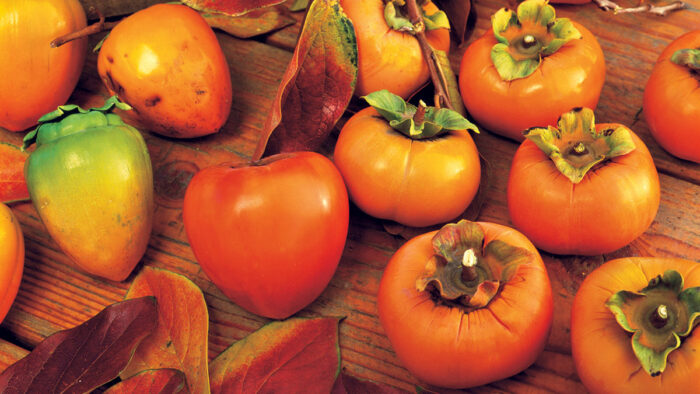
Two Asian persimmon trees dwell in our garden. Each is well behaved, with lovely leaves, attractive bark, and alluring orange fruit. In late autumn, after the leaves have fallen, you can see the persimmons hanging from the branches like softly glowing ornaments set against the darkening skies. Two trees, one common ancestry, bearing two distinctly different fruits.
One, a ‘Fuyu’, bears squat, yellow-orange, firm fruits that are sweet and flavorful as soon as they color up. You can eat them like apples, right from the tree. Not so the large, acorn-shaped, red-orange fruits of the other tree, a ‘Hachiya’. They can easily tantalize the novice by looking and feeling soft and ripe, but they taste tongue-numbingly astringent. It took a lot of trial and many mouthfuls of error before I learned that a ripe ‘Hachiya’ must be very, very soft to be palatable. If you wait to harvest them until just before they fall, when the skin color suddenly darkens and loses its sheen, the flesh will have lost its astringency and will be silky and sweet.
Both trees are now essential to our kitchen garden. They are easily maintained, forgiving of neglect, and, in addition to adding dramatic brightness to the fall landscape, they bring fresh fruit to the kitchen long after the last apples have fallen.
‘Hachiya’ and ‘Fuyu’ are the most popular representatives of the two categories of Asian persimmon—astringent and nonastringent. Both are seedless, although there are many varieties with seeds. Asian persimmons, called kaki in much of the world, were brought to the United States about a hundred years ago. They had relatives already living here, the small, American persimmons that grow wild over the eastern United States. By the time these large, sweet foreigners arrived, in the mid-1800s, they were already well bred. More than two thousand varieties had been cultivated in China and perhaps hundreds more had been developed in Japan. For many years ‘Hachiya’ was the most widely planted variety. ‘Fuyu’ is now much more common.
Persimmons aren’t fussy, just slow
Persimmons take several years to bear, but be patient—they’ll be with you a long time. If you’re intrigued with the fruit but feel daunted by the relative scarcity of recipes, fear not. The trees make good landscape specimens. The canopy casts excellent shade for summer napping, the leaves have bright fall colors, and the bark is craggy and exotic.
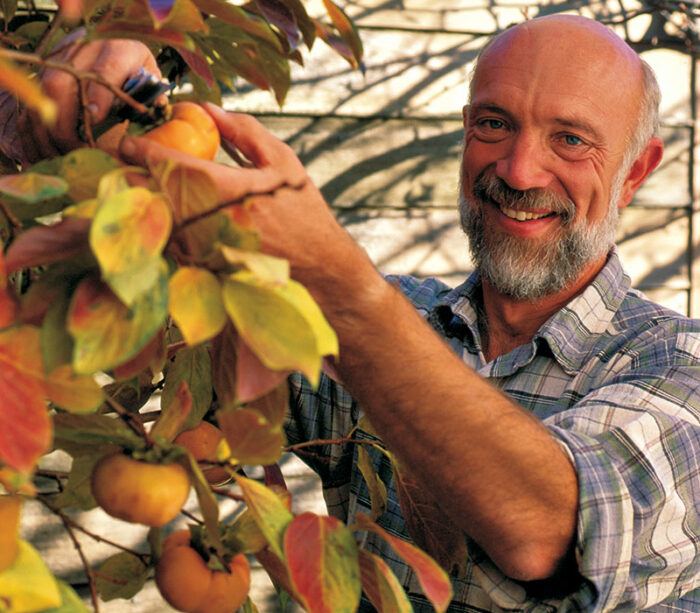
Asian persimmons are native to warm temperate and sub-tropical climates, but they can tolerate some cold weather and heavy soils, depending on the rootstock. ‘Fuyu’ and ‘Hachiya’ will thrive in Zone 7 and warmer. ‘Hachiya’ does especially well in California. ‘Tanenashi’ and ‘Eureka’ are astringents appropriate for Zone 8 and warmer. Some cultivars will produce fruit, although inconsistently, in colder climates. Among them are ‘Saijo’, an old astringent Japanese variety, and the non-astringents ‘Jiro’, ‘Yamagaki’, and ‘Ichi Ki Kei Jiro’, which are all hardy to Zone 6. Unless you live in California, choose a tree that’s been grafted onto the hardier American persimmon rootstock, Diospyros virginiana.
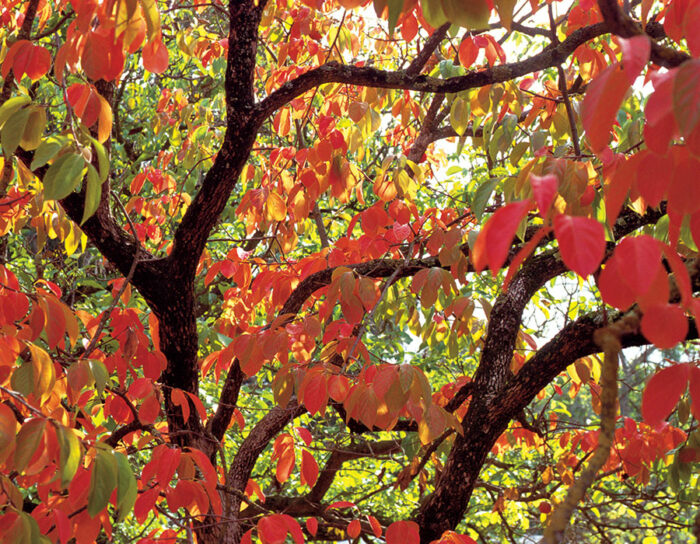
Persimmons tolerate a variety of soils, but like so many plants, they perform best in a deep, well-drained one. Plant your tree in full sun in a hole just big enough to spread out the roots. Roughen up the sides of the hole to encourage the roots to grow into the surrounding soil. (A smooth surface can keep roots circling round and round.) Backfill with unamended soil, tucking it up under the roots to avoid leaving any air pockets. Make sure the graft union is a few inches above soil level and that the soil is mounded, because considerable settling will occur when you water. I like to sprinkle a few handfuls of organic fertilizer on the soil around the trunk. Then spread a 4- to 6-inch-deep layer of mulch around the tree in an 18-inch radius, pulling the mulch a few inches away from the trunk to keep moisture from accumulating next to the bark. Water thoroughly.
I recommend doing a little pruning at planting time. If the tree is a young bare-root whip, cut it back by about a third, making a slanted cut just above a bud. If it’s more mature, with plenty of branches, do some thinning to begin establishing a strong framework of well-spaced limbs.
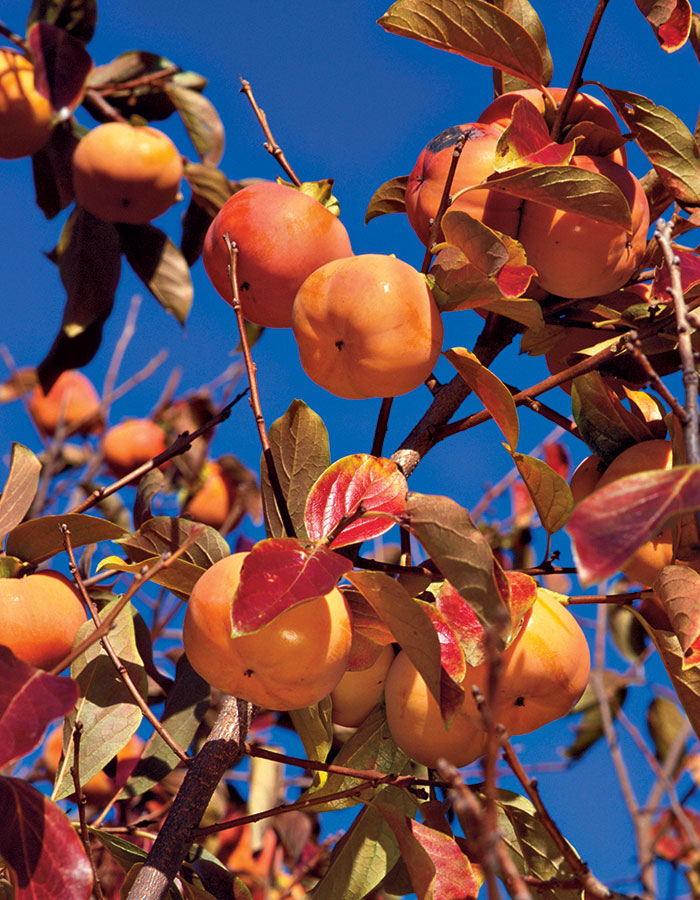
Newly planted trees of any kind are often slow to leaf out. Because persimmons leaf out based on number of hours exposed to warmth rather than on exposure to chilling, they can be slower than most. In some areas, a newly planted persimmon may not break dormancy until late summer or fall. If you begin to worry that your tree is dead, nick the bark with a fingernail or knife. If you see green beneath the bark, the tree is just resting.
Ongoing care is no big deal
Continue to irrigate the persimmon regularly, especially during the early years, while the tree is getting established. For the biggest yields and best-quality fruit, persimmons need about 40 inches of water a year, although they can get by with less. Our 12-year-old ‘Fuyu’ is in a part of the garden that gets no water other than the 20 inches or so that fall during the winter, and it stays healthy and productive.
You can prune the tree to either a central leader or an open center configuration. Fruit forms in the axils of new growth that arises from 1-year-old wood. To encourage new growth, I prune lightly in winter while the tree is dormant, cutting back willowy growth and thinning out branches that are closer together than 6 inches. I keep on pruning throughout the rest of the year, shortening branches, and removing any crossing, inward-growing, or diseased branches. I try to encourage air circulation for disease control, and light penetration for increased fruitfulness.
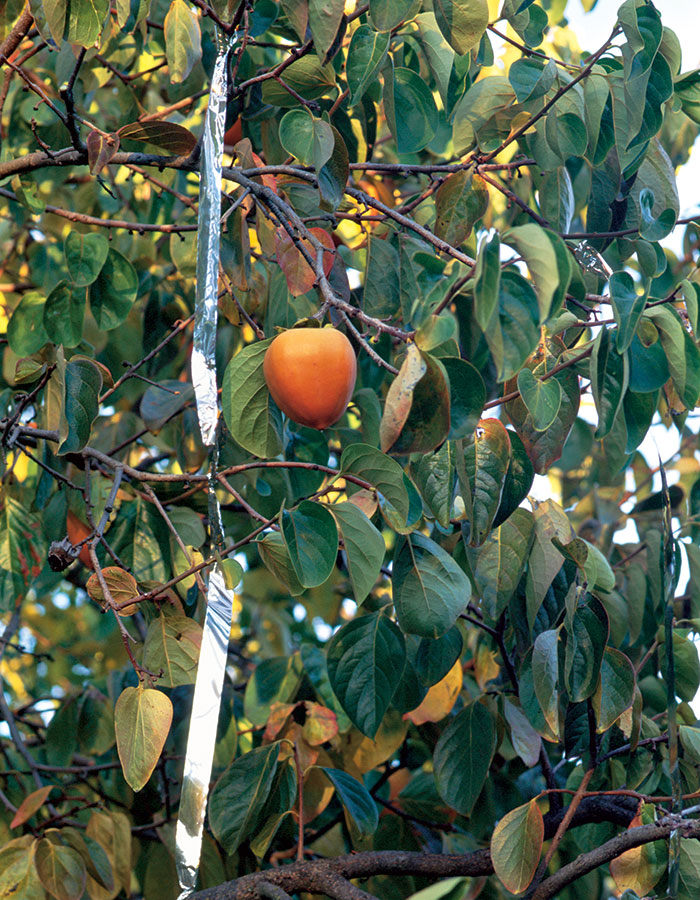
The trees flower in spring. I’m always excited to see the ‘Hachiya’ set so many fruits. I dream about persimmon puddings (see recipe, facing page) and I rummage through my cupboards looking for the pudding mold. Alas, by midsummer most of the immature fruits have fallen to the ground, and I’m reaching for my rake. The ‘Fuyu’ seems to drop far fewer fruits. Since I dread the monotony of fruit-thinning, any tree that thins itself is welcome. I still have to remove the occasional ungainly fruit if it threatens to break a branch.
If you take care of your tree, water it, keep it mulched, fertilize it when annual shoot growth is less than 12 inches, and protect it from gophers and deer, in about five years you should get a good crop of persimmons. Here in northern California, they begin ripening with the first rains of fall, usually in mid-November. The ‘Fuyu’ persimmons are ready just before Thanksgiving, and the ‘Hachiya’ a couple of weeks later. Though not-quite-ripe Fuyus are edible and sweet when they’re amber-colored, they’re better when they turn solid orange and begin to soften. They stay firmly attached to the branch, so I harvest them with shears. Since Hachiyas aren’t ready until they feel as if they’re about to rot and the skin looks almost translucent, I hold them gently in one hand and clip them carefully from the branch by cutting just above the calyx. I stand them upside down, on the stem end, until I’m ready to use them. You can harvest Hachiyas underripe and let them soften, but the flavor is deeper if they ripen on the tree.
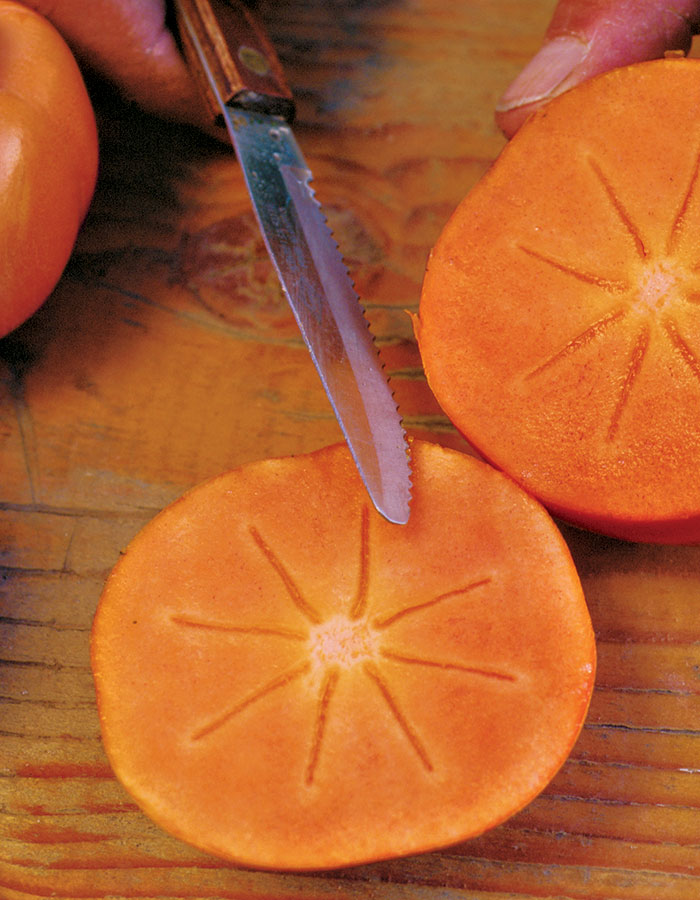
The trees are largely trouble-free. I’ve seen a few mealybugs on the fruits, but no damage. Birds are the most destructive pests. They eat the persimmons starting at the top so you can’t see the damage from ground level until it’s too late. I sometimes add Mylar tinsel to the trees to try festively to discourage the more timid birds. Deer seem to enjoy the lower leaves. People passing by seem to enjoy the lower fruits.
There’s a magical and melancholy moment at the end of persimmon season. The bright yellow leaves have fallen and are lying under the tree. The leaves reflect the light from the winter sky, illuminating the undersides of the branches. The misty air glows faintly, and the fruit hanging in the bare tree turns golden. It’s as though a piece of the sun falls to earth to help the garden put on the last show of the year.
Each type has its own best uses
The distinct qualities of the astringent ‘Hachiya’ and nonastringent ‘Fuyu’ persimmons require that they be used very differently in the kitchen. Peeled and sliced thinly crosswise, the crunchy ‘Fuyu’ fruits reveal a lovely star pattern. They’re wonderful in green, composed, and fruit salads (see my recipes for Salad of Bitter Greens and Persimmon and Persimmon and Fennel Salad). For a stunning and delicious fall salad, try combining them with bitter greens and a citrus-ginger vinaigrette. I find the flavor of a cooked ‘Fuyu’ to be almost too subtle, but it does add color and an interesting note to compotes, chutneys, and relishes. Bread pudding made with ‘Fuyu’ persimmons and golden raisins, and sprinkled with crystallized ginger is delicious.
Many of our ‘Hachiya’ persimmons never make it to the kitchen. I cut off the top and eat the jellylike pulp with a spoon. The flavor is unique, somewhat like a mango or a peach, but always in the background is that distant astringency. Those that do reach the kitchen find their way into long-anticipated holiday puddings, cookies, and quick breads. I’ve even used them in pies and ice cream.
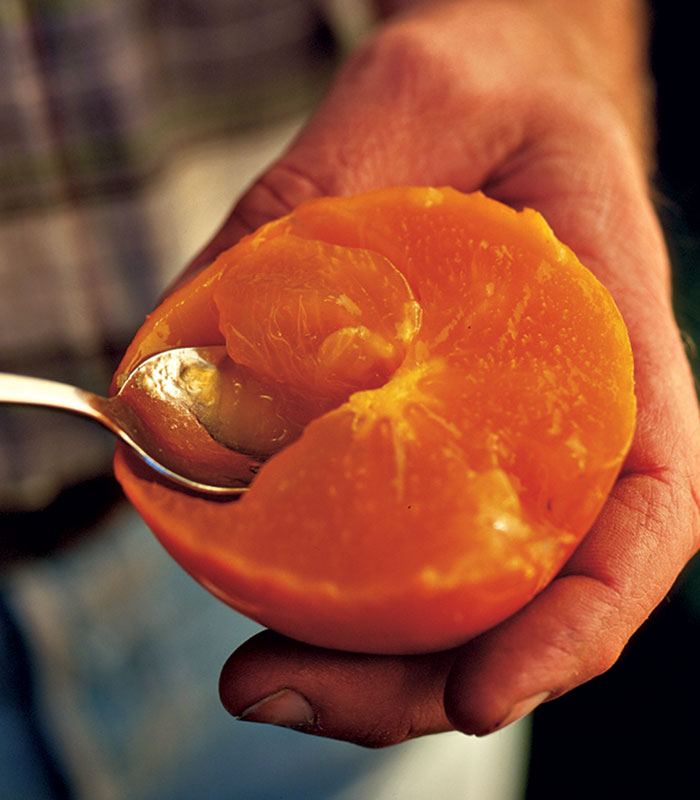
To preserve persimmons you can make jam (be sure the fruit is ripe), freeze the pulp, or slice and dry them. A firm, inedible ‘Hachiya’ becomes surprisingly sweet when dried. Use a dehydrator, or if you live in a dry climate, try the holiday decorating technique a gentleman once described to me: peel the fruit and hang them whole from strings inside the house until they’re dry. Just remember to duck!
Sources for Asian persimmon treesEdible Landscaping Raintree Nursery Stark Bro’s Nursery |
—Joe Quierolo is a contributing editor to Kitchen Gardener. He gardens in San Ramon, California. Kathleen Stewart owns The Downtown Bakery and Creamery in Healdsburg, California.
Photos except where noted: Saxton Holt.
December 1999
from Kitchen Gardening #24

















Comments
Your guidelines are pretty effective for growing persimmons either in fields in large scale or just for amateur farming in home. It needs special care especially in drastic weather. Here I find http://www.essaywritingnz.com website to get the best writing assistance for spreading guidelines about growing vegetables or fruits to make the environment eye-catching.
Asian persimmons include varieties such as 'Hachiya' (left) and 'Fuyu' (right). Asian persimmon trees have brilliant fall color, an attractive branch structure, and interesting bark.
https://get-shareit.com/
https://get-vidmateapk.com/
You can prune the tree to either a central leader or an open center configuration. https://jiofilocalhtml.run https://forpc.onl
reeze the pulp, or slice and dry them, its important https://jfi.cam/jiofilocalhtml/
Amazing article full of information, thanx for sharing.
Looking for more updates ! https://mybk-experience.onl https://www.mcdvoicesurvey.onl/
Thanks for the article. I am very pleased to have read this article. I think it will be an example for essays writers on web-site https://essays-writer.net/. Many people like to read essays that will be interesting.
That's a great example indeed. In Rajasthan though, for all these services, we use the SSO ID Login page - https://kijankari.in/sso-id-login-kaise-kare/
Great article. This blog is filled with unique and high-quality articles.https://www.playstoreinfo.com/, https://www.techsolveguide.com
Thanks for the Gardening tips. I have a great tips to grow terrarium garden at home. Read:- https://bestsmarthomeart.com/how-to-make-terrarium-garden-at-home/
Log in or create an account to post a comment.
Sign up Log in